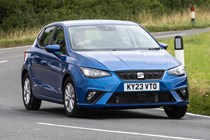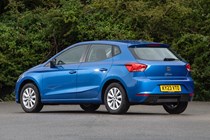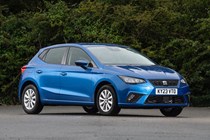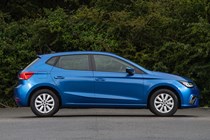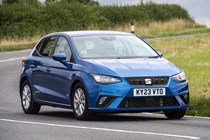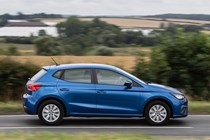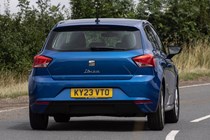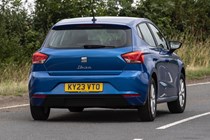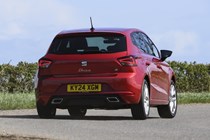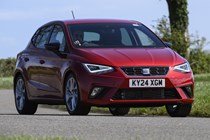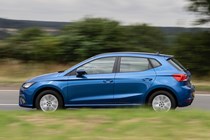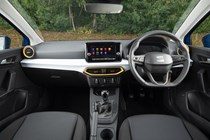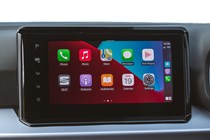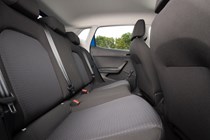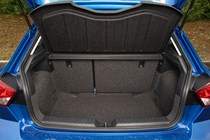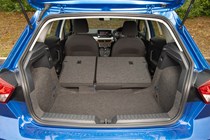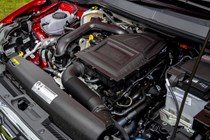
SEAT Ibiza long-term test

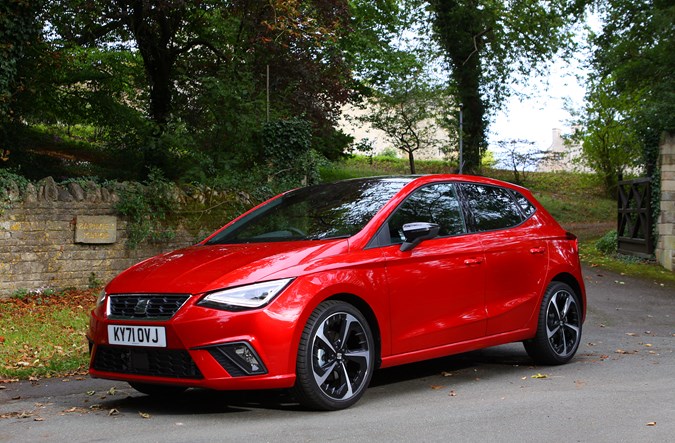
We’ve got a SEAT Ibiza with the ‘Beats’ premium sound system, so we let audiophile and radio afficionado Percy Lawman crank up the dB’s
– follow our journey and experiences here…
Report by Percy Lawman – Senior Product Content Manager
Jump to:
- Update 2: Interior, equipment, specs and safety
- Update 3: Driving, engines, performance and handling
- Update 4: Buying, owning or hiring your Ibiza
- Update 5: Ibiza beat – ‘BeatsAudio’ optional upgrade
Update 1: Introduction
It’s the end of the summer [well – what summer we had] and Parkers has had a new arrival creep in whilst we weren’t watching. SEAT’s brand new ‘Desire Red’ FR Ibiza landed in the car park at Media House and I’m really pleased to be the one to give this stylish new arrival a run throughout the later part of the year and into 2022.
If you hadn’t noticed, the Ibiza was a former winner of ‘Best First Car’ in the Parkers 2019 New Car awards. That success story continues as the Ibiza showed what it took to be on the podium again, taking the runner-up slot for 2022.
The Ibiza shares some of its underpinning with the Audi A1 and VW’s Polo – both very competent performers. Other big hitters such as the Ford Fiesta and Parkers ‘Best First Car’ winner for 2022 the Renault Clio are also clamouring for a piece of the action.
We like the Ibiza’s spacious and solid-feeling interior, and we love its range of perky, efficient engines, which range from sensible and sedate to really rather rapid. It looks good, drives well, is great value, and very cheap to run – it’s no wonder this is such a good choice for people looking for the ultimate first car.
The present Ibiza model range [2017 onwards] comes in six distinct trim levels. The base spec SE model [starting from £16,790], the SE Technology [starting from £17,735], the FR [starting from £19,050], the FR Sport [starting from £19,915], the XCELLENCE [starting from £19,795] and the XCELLENCE Lux [starting from £20,655]. We’ve been lucky that our nice friends from SEAT’s press office have supplied us with a brand-new sporty spec FR Sport.
Our own car is KY71 OVJ, a 1.0TSi FR Sport 110ps 6 speed manual in a sparkling ‘Desire Red’ metallic paint with FR Navy and Black cloth upholstery. We have three factory fitted options, a ‘Space-Saver’ spare wheel [£105], the ‘Beats’ premium sound system [£495] and a Panoramic Sunroof [£685]. Other options are also available but we’ll look more in finer detail on what else is on the table further into the review. We’ve also got some very nice media shots of SEAT’s exact same spec sister car, KY71 OVC just to enhance your appetite.

Over the coming months we’ll look at the car based on an owner’s perspective, letting you know what we like and also what we think doesn’t hit the mark. Apart from daily driving and now limited commuting, we’ll look to stretch the Ibiza’s legs on longer journeys including a long-weekend away in Wales and the odd journey to the North West of England. There may even be something a little more off-the-beaten-track into 2022 but more on that later.
So, sit back and enjoy the ride whilst we pump up the dB’s – cruising along to our favourite road-trip tunes.
Update 2: Interior, equipment, specs and safety
The list of standard fit kit is actually stunningly good and at ‘FR Sport’ trim level the owner is spoilt with a very comprehensive list.
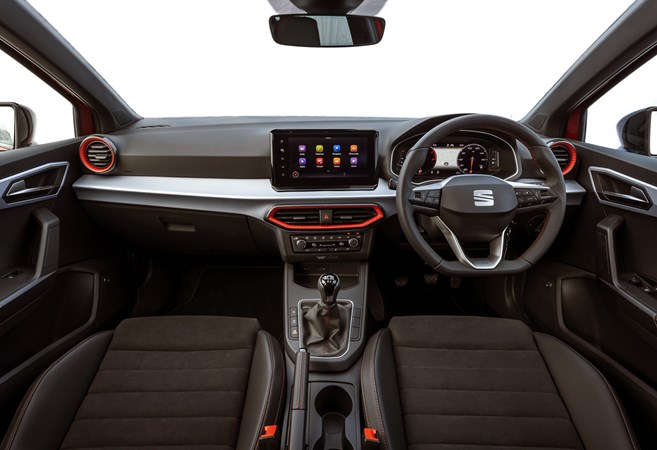
In standard trim, the FR Sport radiates in the late Autumn sunshine, the included ‘Desire Red’ metallic paint gleaming brightly. A big chunky set of 18” ‘Performance’ machined black and grey alloys really set it off. They look great fitted with the premium ‘Bridgestone Turanza’ 215/40×18 rubber making the car sit very low. Saying that, there’s ample space [about 8cms] between the base of the wheel arch and the tyres, so any bottoming out of the suspension is an unlikely scenario.
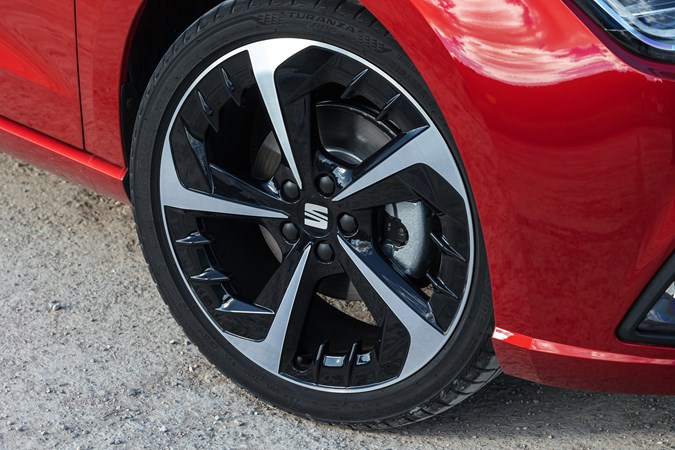
Modern LED lighting technology plays a major part in the Ibiza’s DNA, with full LED automatic headlights with dynamic headlight range control, a ‘Coming and leaving home’ feature, LED daytime running lights and LED taillights.
Fog lights front and rear are included [as they are across the whole range of trim levels] – and both door mirrors are fully electric and folding.
The 9.2” colour touchscreen navigation system is included on all trim levels from SE Technology upwards. Only the base spec ‘SE’ features the lower end 8.25” unit. ‘SEAT Connect’ is featured [again across the full range] and from SE Technology trim upwards includes Safety, Service, Remote and Online. A 12-month online subscription is also included in the package.
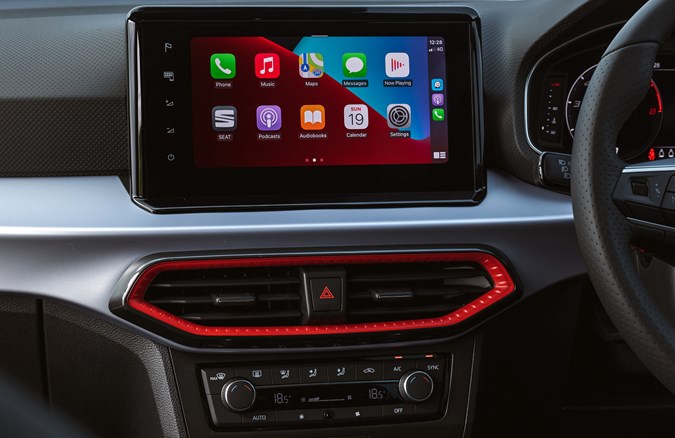
Inside, comfort is given a major boost to the next level with seats in a ‘Microsuede’ material and we can testify – they are really very good and look cool. Dual-zone climate control is standard fit over and above the normal air-conditioning and rain sensing wipers add to the already very comprehensive equipment mix.
As previously mentioned, our 1.0TSi FR Sport has 3 factory fitted options, a ‘Space-Saver’ spare wheel, the ‘Beats’ premium sound system and a panoramic sunroof. Rather than flood the range with a multitude of options, the manufacturer has wisely selected what we’d class as ‘Useful Buyer Options’ – adding user functionality rather than charging a few hundred pounds for some flashy metallic trim that doesn’t actually do anything.
In addition to the three options already fitted, buyers can select Rear Parking Sensors [£225], Perimeter and Interior Monitoring Alarm [£160], a Safety and Driving Pack [£230] which includes Adaptive Cruise Control, High Beam Assist, and Dynamic Road Sign Display and finally an enhanced version of the Safety and Driving pack [£355] which additionally has an active Lane Keeping System and Traffic Jam Assist. All-in-all a feature rich options list.
Inside, the cabin can easily fit 4 adults and one child. I’d say it would be a push to get 5 adults in, but you could potentially for a short journey without too much trouble if everyone’s happy to huddle up. The caveat being, the person in the rear center doesn’t have the luxury of a ‘proper’ microsuede trim seat – however, it’s a workable situation as there’s three fully fitted seat-belts in the rear of the cabin. The seating is very comfortable, enhanced by the smooth microsuede trim. We’ll let you know in the months to come how the Ibiza shapes up on longer journeys.
Around the rear of the car the boot [at 355 litres] is over and above that of its rivals with the Audi A1 at 335 and the VW Polo at 351 litres respectively. Road tax [per annum] is £155 and you’ll being looking at around Group 12 for insurance purposes. You can see the full specs here on Parkers.co.uk or if you want to search for another car in any of our comprehensive data sets, then start here.
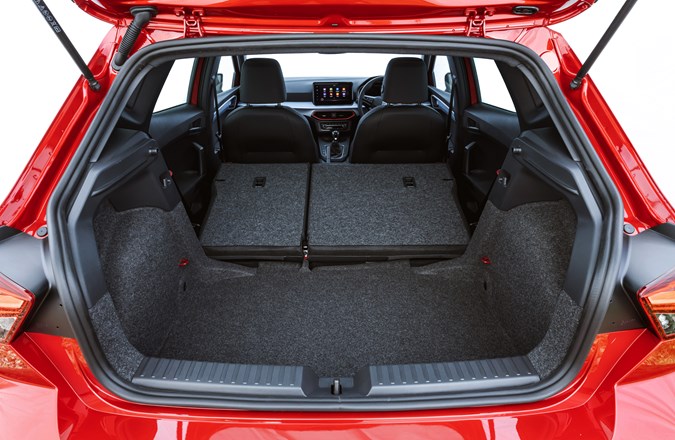
Out and about in the real world, we took the car on a requisite shopping trip to see how many shopping bags we could lever into the boot. It’s a fairly standard Parkers test, so the Ibiza was whisked away to our local Aldi and duly put to work.
As a comparison on a previous supermarket jaunt, I managed to fit in eight fully laden shopping bags into VW’s new MK8 Golf. The Golf has a published boot space of 380 litres, so only a mere 25 more than our Ibiza. I had pretty good vibes that I’d be able to get all eight in.

Our car didn’t disappoint and on reflection was just as easy. Everything went in without squashing any loaves or flatting out any of the other produce to floor. If anything, the perceived impression [whether rightly or wrongly] was that the Ibiza’s boot [seemed] be actually larger. All-in-all a good exercise proving the Ibiza was well up to the task.
If safety’s on your mind, then you’ve no need to worry. SEAT’s current Ibiza range [2017-] commands the top score [5-Stars] from Euro safety experts ‘Euro NCAP’. It’s also testament that the previous Ibiza range [2008 onwards] also scored the maximum 5-stars during its pre-2009 and 2011 evaluations. So, with its’ array of Air-bags, an Electronic Stability Control System and Emergency Brake Assist to name just a few safety wizardries – the Ibiza is a solid and safe place to be in.
Check back with us later in the month when we’ll take our new Ibiza on a long weekend jaunt to North Wales.
Update 3: Driving, engines, performance and handling
With a mere 700 miles on the clock [all of which was local and semi local ‘runabout’ trips], it was time to take our new acquaintance out on its first ‘real’ road trip. My daughter lives in Snowdonia, North Wales so we lightly packed for a 2-night stay. Since the arrival of the car back in early October, I’ve not noticed any loosening up of the fairly tight engine. Obviously, this is to be expected with a brand-new power unit. Over time and as a vehicle puts on a few thousand miles, engines generally become more responsive as they loosen up and components bed-in. It’s akin to the old ‘Running-In’ process back in the 70’s where it was best not to stress a new engine too much. With modern manufacturing techniques and better tolerances, it’s not so much of an issue in today’s world. Saying that, I’m still a bit old-school here and was happy not to work the engine too heavily giving myself a target max of 3000rpm in the first 1000 miles and 4000rpm in the next 1000. I’ve done the same with new test cars in the past and the engines in previously owned long-termers loosened up very nicely and were excellent power units. The theory works – so I’ll stick with the plan.

So, time to get an idea of a route. Checking Google Maps, I planned a route into North Wales following the A14, M6 and A5 and on the return, we’d backtrack to Telford and then follow the old A5 [Watling Street] back down to Lutterworth which avoids the M6. A round trip of just under 400 miles. The route gave us a mix of faster ‘A’ roads, motorways and some twisty winding Welsh mountain roads.
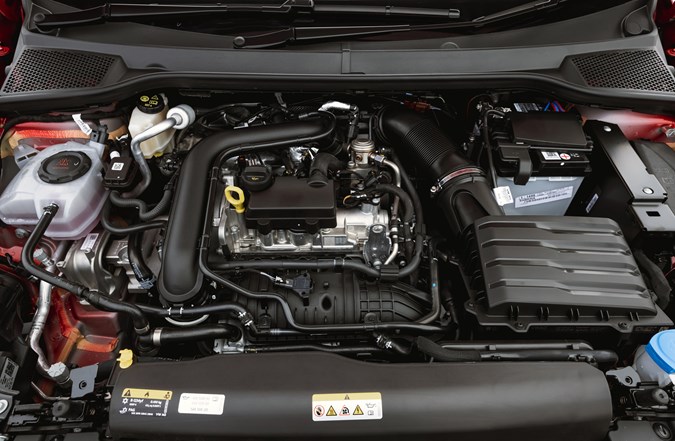
Our Ibiza is fitted with the 1.0 TSi [110bhp] engine. It’s a 3 cylinder 6-speed manual affair and has a lovely warm rumble when worked hard. During the first stint of ownership, I’d noticed that fuel consumption was hovering just below WLTP figures, so I was happy to see that things had improved to just over WLTP following our Welsh trip. The fact that the engine was bedding in nicely, bodes well for the coming months as ‘tight’ new engines often fail to hit their advertised mpg mark.
We’d managed to improve the figure to 53.41mpg after brimming the car a few days prior to departure and then running the whole trip back home. A full tank of 38.50 litres [£55.02] gave us a distance of 470 miles before the ‘Range Remaining’ hit zero. An equivalent to 11.75 [MPL] miles per litre. Unfortunately, with the horrific price of fuel today [Oct 2021], the ‘MPP’ [Miles Per Pound] has reduced somewhat to 8.54. Saying that, the Ibiza is still a frugal partner to have out on the road.

Out and about on the open road, our cruise was between 60 and 65 mph, so nothing too strenuous. At 2000rpm, the Ibiza would cruise nicely at around 60mph which was ideal for ‘A’ roads and of course keeping within the speed limits. The engine responded well to some of the more challenging twisty Welsh roads and there was a noticeable punch in the torque at around 3000rpm as the car worked harder on the hills.
The steering on the Ibiza has a nice feel with good feedback to the driver. Handling was precise and enhanced by switching the drive mode to ‘Sport’ in favour of ‘Normal’. This user selectable feature also stiffens up the suspension making the ride slightly firmer. It’s rather like a ‘Fast-Road’ setting as such and on the faster twisty ‘A’ roads, the Ibiza would steer nicely into bends helped by the wide 18-inch alloys and chunky 215/40×18 tyres without any hint of getting out of shape.
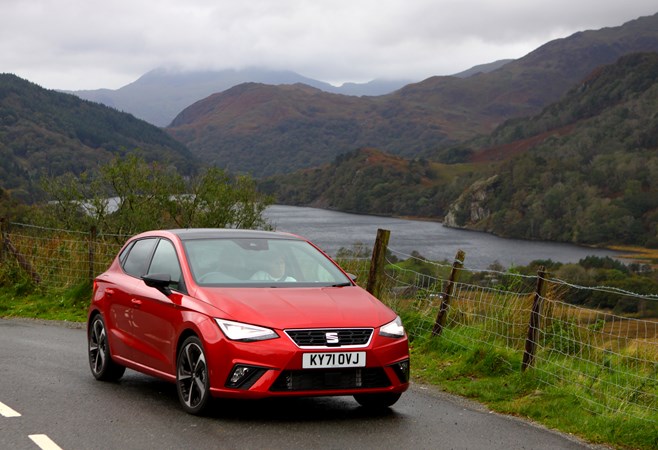
A point to notice is that the 1.0TSi power unit comes up to normal operating temperature fairly quickly. On a cold morning around 5 degrees centigrade, the temp gauge was reading normal only after travelling about a mile and zero warm-up time. This should be very useful on those cold winter mornings when trying to defrost your windscreen.
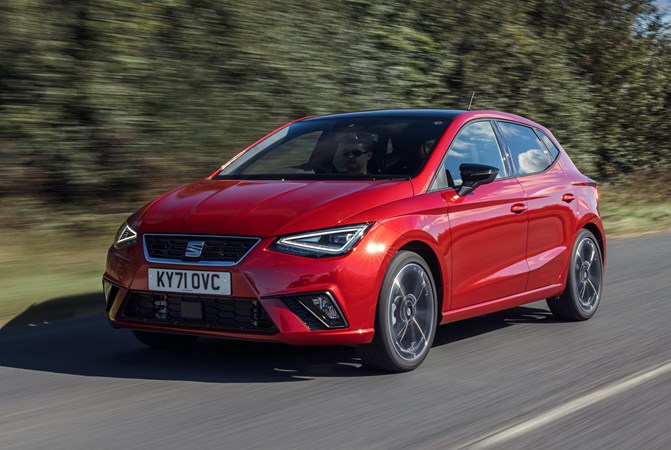
All in all, our trip across the border was a great first test for the new Ibiza. It passed the test with flying colours and we’re expecting more exciting road trips as the months pass. I’d not be surprised to see the fuel economy improving further as the overall mileage increases. I’d bet, over 55mpg if past experiences with new engines is anything to go by.
Update 4: Buying, owning or hiring your Ibiza
‘New Year – New Car’ – sounds like a decent plan for 2022. With the country more or less being very much restricted on things like travel and some leisure activities, many people have actually built up some spare financial collateral during the Covid lockdown period. OK, things are easing up somewhat, but it’s an opportunity to shift direction away from the ‘normal’ holiday outlay. Just think, taking a family of four for a foreign summer holiday can often cost many thousands of pounds.
So, let’s move direction and you’ve convinced yourself and ready to take the plunge. Let’s dissect the ins and outs of it all and see what options are on the table so you can get your hands on some nice new gleaming metal.
Buying Outright
This was the old school way of doing things. If you have the cash, then you can purchase the car outright. The car is yours from day one and there are no restrictions on things such as mileage which will need to be taken into account for other ‘owning’ options [like ‘PCP’ or ‘PCH’ for instance] – but more on those later.
Some buyers may want to consider taking out a loan to pay for the car, this then gives them the opportunity to pay monthly over a given set period of time. Loan periods of 5 years would be considered an average but options for shorter and also longer period are often available as everyone’s’ personal circumstances are different.
When considering a loan, the most important factor is ‘APR’ [Annual Percentage Rate]. In essence, the higher the APR – the more you pay back to the lender in interest charges. So, the lowest APR is normally the key to the best deals.
Being impartial, Parkers always looks for the best consumer deals and over the years, we’ve never been disappointed with the loans offered by ‘Tesco Bank’. You can nearly always find a 5-year deal with a super low APR of 2.8%. Other loan periods are availabe although the APR may differ especially if the length is increased – we’d advise checking prior.
Here’s an example of what to expect based on a *loan of £22,125 which is the full price of our car.
Cash Price of Car: £22,125
Loan: £22,125
Provider: Tesco Bank
APR: 2.8% Fixed over the full term of the loan
Loan Term: 5 Years [60 months] – Fixed
Monthly Payments: £395.24
Total Repayments: £23,714.40
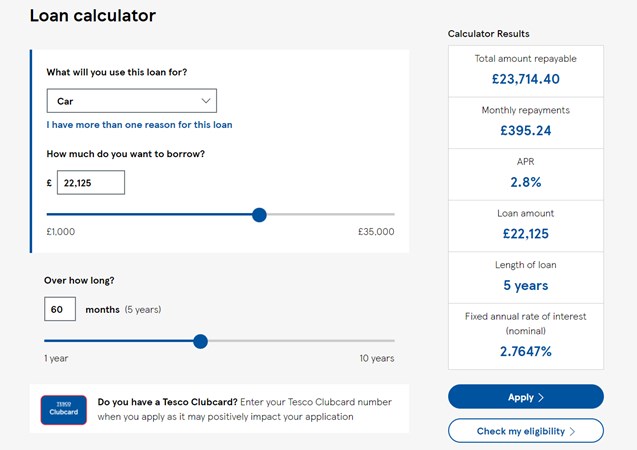
Can I get the car even cheaper?
Yes you can! We’ve scoured the web to find you the best deals around and our trade friends at ‘Broadspeed’ are currently advertising various trim levels of the new Ibiza with a saving of around £3000 on the RRP. If you took out the same loan from Tesco Bank, this would reduce your monthly repayments by £50 to £341 per month based on a loan of £19,125 over 5 years.
Think of it this way. £50 saved monthly over 60 months equates to £3000. That would pay for a nice holiday now – wouldn’t it!
Buying on PCP
PCP stands for ‘Personal Contract Purchase‘. It works by spreading the price of a car across a deposit, a series of monthly payments, and an optional final payment. Typically, a PCP finance agreement lasts between 24 and 48 months.
Unlike with a bank loan – where you pay for the whole cost of the car over the contract – with PCP you just pay for the depreciation. That’s the difference between the initial price and what the car is expected to be worth (the Guaranteed Minimum Future Value GMFV) when you hand it back.
We’ve got more on PCP from Parkers Finance guru Murray Scullion here with a full rundown and video explaining on how it all works.
Current PCP deals are available directly from the manufacturer.
A car-loan scheme using PCH
PCH stands for ‘Personal Contract Hire‘. The key word here is ‘Hire’.
Personal Contract Hire (PCH) – also called leasing – works much like a form of long-term rental. Put down a deposit (known as an initial rental), pay a series of monthly payments, then when your contract is up, you simply return the vehicle and start again.
At a time where finance makes up more than 90% of new car sales, many people are switching to PCH agreements in particular as they are the simplest way to drive a new car. There’s no option to buy outright, so there’s no agreed value and no dealer calling you towards the end of your contract with a ‘once in a lifetime’ deal. But – you never own the car.
Murray continues with an in-depth explanation of PCH and how it all works here.
Parkers has teamed up with industry experts ‘Zen Auto’ who offer some great leasing deals.
Start your search here.
Depending on the trim level, you can lease a brand-new Ibiza for as little at *£205/month [or *£236 per month] based on an Ibiza FR Sport 110ps manual.
Residual Values
One thing to consider when you buy a brand-new car is the ‘Future Residual Value’ or ‘FRV’ as it’s known in trade circles. The FRV is the estimated value of a car at some point in the future. This may be any number of years, but as vehicles tend to lose the most during the first three years of ownership, an FRV at 3-years is a good indicator. After this initial period, the percentage annual decrease reduces somewhat. It’s a real swings and roundabouts affair as some ranges depreciate very quickly. Certain ranges we see only hold 30-35% of their original value. On the flip-side, some premium ranges hold their valves very well [over 50%] for example.
Take a look below at the FRV on our Ibiza. Thanks to our trade partners at CAP/HPi for the supply of data.
Click the image below for a hi-res version.

Our own Ibiza holds up very well. In actual fact it sits at 52% after 3 years based on 30,000 miles covered, using our 10,000 miles per annum average. Saying that, the average mileage generally during Covid has plummeted to around 7000 miles p/a for many private motorists. At this level, our car would have only covered 21,000 miles and would enjoy an FRV of around 54% – figures which indicate the SEAT Ibiza as a premium range and brand.
*Deals in Update 4 are correct at time of publication [January 19th 2022]. Everyone’s financial circumstances are different and credit is not always available – Parkers cannot recommend a deal for you specifically. These deals are indicative examples of some packages available this week.
Check back with us in February, when we dig deeper into the workings of the optional ‘Beats Audio’ package.
Update 5: Ibiza beat – BeatsAudio optional upgrade
‘Ibiza Beat’ makes a return in 2022 as our new FR Sport is kitted out with the latest ‘BeatsAudio’ optional sound system. I’m excited to be able to get my head around the latest flavour of ‘Beats’, although to be fair, I wasn’t pushed to over excitement in previous experiences which included two other long-termers that had the option – these being the SEAT Arona in 2018 and the VW-T-Roc in 2019.
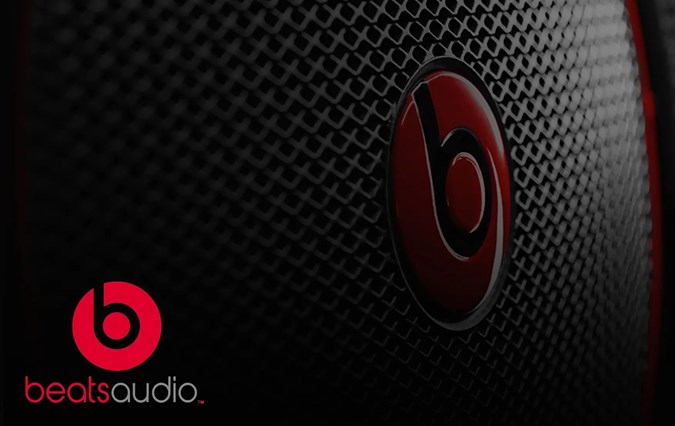
The Beats brand was founded by music producer and rapper Dr. Dre and Interscope A&M records co-founder Jimmy Lovine back in 2006 and is synonymous with the rise in popularity mainly of electronically EQ’d ultra-expensive aftermarket headphones. An area frequently sneered and jibed at by true audiophiles.
So, with some extra years under its belt, we’ll look how ‘BeatsAudio’ has evolved.
Focussed as an integral part of the 9.2-inch capacitive infotainment touchscreen, the audio settings are a very straightforward affair to access. Just select ‘Radio’ and then the station – and the ‘Settings’ menu is easily visible on the left-hand side. Selecting the ‘EQ’ I’ve immediately noticed a change in direction. As highlighted here on a previous ‘Beats’ teardown, gone is the very limited 3-band graphic EQ having been replaced by a much more user friendly 5-bander.
The new graphic is actually 4 bands plus the subwoofer as the lowest EQ band purely controls the output response from the sub at frequencies below 125Hz. It also splits at the following additional frequencies, 250Hz, 1kHz, 5kHz and 10kHz. I think they’ve moved in the right direction giving listeners much more input, but the lack of any control of the higher frequencies was rather disappointing not to see.

In today’s modern audio offerings, speakers will quite readily handle frequencies up to 20Khz – even modest full range units. The fact that the Ibiza has two dedicated top-end small tweeters located in both ‘A’ pillars suggests that these frequencies are more or less based on pre-set values output from the onboard amp. More control for the higher frequencies would certainly be a preferred route which then would give the user full control of the whole audio spectrum – rather than just most of it.
We were still surprised to find a lack of some ‘factory pre-set’ EQ curves which would be useful to select thus automatically setting the EQ to suit different listening genres. This was apparent in older Beats flavours and seems not to have moved on.
The ‘BeatsAudio’ premium sound system which equips the Ibiza comes with a 12-channel 300-watt amplifier [which is up from the older 8-channel unit], digital signal processor and 7 premium speakers. There are two tweeters in the ‘A’ pillars and two woofers in the front doors, two full range speakers in the rear, as well as an integrated subwoofer. As in previous incarnations of ‘Beats’, the subwoofer is quite a clever affair being mounted inside the space-saver spare wheel. It’s a novel idea because you get the bottom-end frequencies of a discrete subwoofer without having to sacrifice any additional boot space. The effect is good and gives the listener a much more improved ‘bottom-end’ response.
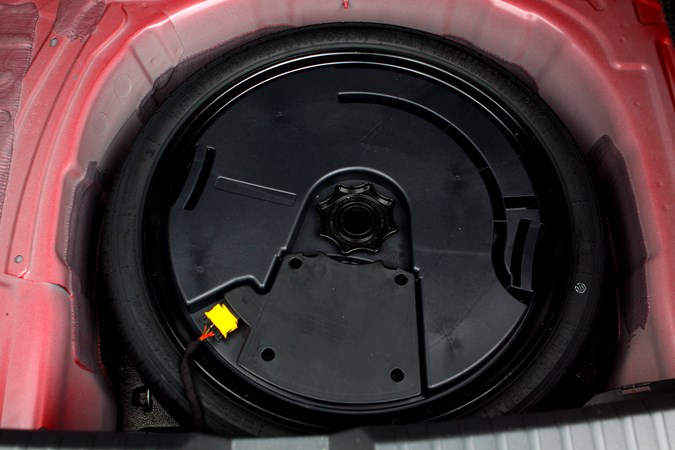
So, what does it sound like? Well, one improvement we found was that the previously ‘over gained’ midrange has been knocked back somewhat. The additional channelling of the revised amp could well be behind this and the output is now much smoother which adds to the quality. The reduced ‘harshness’ works well and makes listening seem and feel to be more of a premium affair.
We ran up some of the same .mp3 tracks that were used in the older 2018 and 2019 evaluations and overall, we found the perceived output to be much more pleasant to listen too – even at fairly high volumes.
The additional separate ‘EQ’ing of the sub also made the lower frequencies much more tolerant. Everything seemed to have been smoothed out somewhat and there was a better sense of soundstage. The ‘Sound Focus’ setting also added positively to the mix which enabled the listener to ‘target’ certain areas of the car [literally] by moving a target on the touchscreen to either dip or increase volume in a selected area. It’s akin to a fader on steroids, but it’s actually much more than that. The function also includes pre-sets of ‘All’, ‘Front’ and ‘Driver’ which is a nice touch.
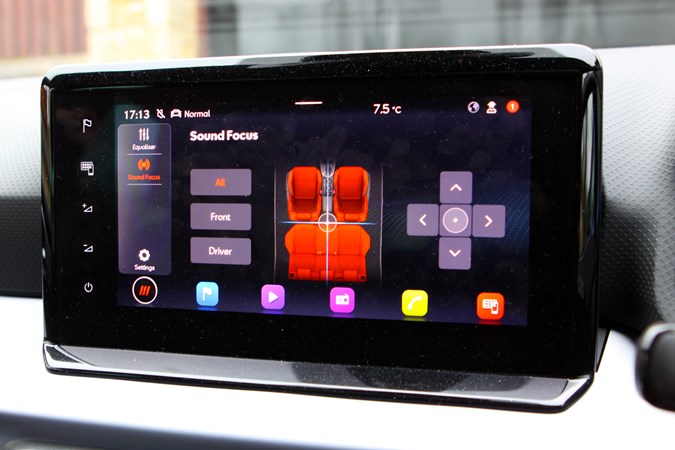
Conclusion
BeatsAudio has evolved nicely over the past few years and the improvements are certainly noticeable. It’s a great option to have and not overly expensive at £495 including VAT. Although it’s aimed more towards the younger generation, the updates since our last visit to the ‘gig’ are encouraging to see and the smoothing out of the whole experience very welcome.
What we liked:
- EQ now splits into 5 bands including individual sub-woofer control of low frequencies
- Amplifier is now a chunky 12-channel affair. Up from the older 8-channel models
- DSP continues to deliver a good low distortion output – it’s still a winner
- Output was much less ‘jumbled’ than before. Improved separation and soundstage
- It’s a ‘good value’ functional option and certainly worth considering
- Improved channel separation compared to previous iterations
What quite didn’t hit the mark:
- EQ lacks any factory pre-sets
- EQ is limited to a max frequency of 10kHz. Pushing to over 15kHz or even higher would be a big plus
| Latest SEAT Ibiza 1.0 TSi FR Sport – Running costs |
|
| Current mileage | 3724 |
| Real-world average fuel economy | 54.42 mpg, (107% of official) |
| Official combined fuel economy (WLTP) | 48.7 – 52.3 mpg |
| Total outlay for fuel | £386.83 |
| Joined Parkers fleet and start mileage | 4th October 2021 [297 miles] |
Percy Lawman – 2nd March 2022


